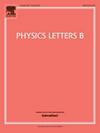对称与非对称碰撞比较:小系统流的解纠缠核结构和亚核子结构效应
IF 4.5
2区 物理与天体物理
Q1 ASTRONOMY & ASTROPHYSICS
引用次数: 0
摘要
以前在小型碰撞系统中的流动测量大多基于高度不对称碰撞(p+Pb, p+Au, d+Au, 3He+Au),其中核结构和亚核子波动都很重要。将这些非对称系统与RHIC和LHC上最新的对称16O+16O碰撞进行比较,提供了一个独特的机会来解开这两种贡献。使用结合核子和夸克级子结构的Glauber模型,我们分析了多重分布和初始状态估计:各向异性流vn的偏心率εn和径向流的逆横向尺寸d⊥。我们发现亚核子波动对O+O碰撞的影响不同于非对称系统,在流动观测中创造了特定的模式,从而能够解开相互竞争的贡献。这样的实验比较将减少初始条件下的不确定性,并提高我们对小系统中产生的类qgp介质性质的理解。本文章由计算机程序翻译,如有差异,请以英文原文为准。
Symmetric-asymmetric collision comparison: Disentangling nuclear structure and subnucleonic structure effects for small system flow
Previous flow measurements in small collision systems were mostly based on highly asymmetric collisions (+Pb, +Au, +Au, He+Au), where both nuclear structure and subnucleonic fluctuations are important. Comparing these asymmetric systems with the newly available symmetric O+O collisions at RHIC and LHC provides a unique opportunity to disentangle these two contributions. Using Glauber models incorporating both nucleon and quark-level substructure, we analyze multiplicity distributions and initial-state estimators: eccentricities for anisotropic flow and inverse transverse size for radial flow. We find that subnucleonic fluctuations impact O+O collisions differently from asymmetric systems, creating specific patterns in flow observables that enable disentangling the competing contributions. Such experimental comparisons will reduce uncertainties in the initial conditions and improve our understanding of the properties of the QGP-like medium produced in small systems.
求助全文
通过发布文献求助,成功后即可免费获取论文全文。
去求助
来源期刊

Physics Letters B
物理-物理:综合
CiteScore
9.10
自引率
6.80%
发文量
647
审稿时长
3 months
期刊介绍:
Physics Letters B ensures the rapid publication of important new results in particle physics, nuclear physics and cosmology. Specialized editors are responsible for contributions in experimental nuclear physics, theoretical nuclear physics, experimental high-energy physics, theoretical high-energy physics, and astrophysics.
 求助内容:
求助内容: 应助结果提醒方式:
应助结果提醒方式:


